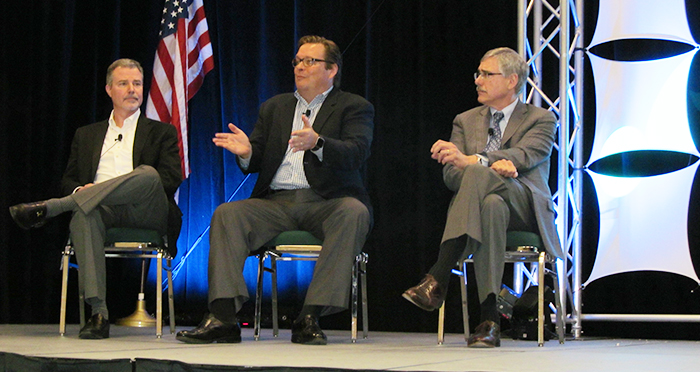(Photo above: Andy Davidson, president and CEO of the Oregon Association of Hospitals and Health Systems, gestures while making a point during a healthcare conference in Redmond sponsored by St. Charles Health System. St. Charles president and CEO Joe Sluka, at left, and consultant Jamie Orlikoff listen | by Steve Kadel)
A nationally recognized healthcare expert told 100 citizens and medical employees recently that the nation’s muddled healthcare industry would benefit if patients became more discerning consumers.
They should ask their doctor more questions, including prices of potential procedures, he said. Jamie Orlikoff encouraged patients to ask physicians, “Why should I spend money with you?” and even “What will happen if I do nothing?”
That was part of the message from Jamie Orlikoff of Chicago, keynote speaker for St. Charles Health System’s conference at the Deschutes County Fair and Expo Center on Saturday, April 15. The event was titled HealthScape 2017:Uncertainty, Opportunity and Reality.
Orlikoff is president of a consulting firm that specializes in issues of healthcare governance and leadership, strategy, quality, organizational development and risk management. He was named one of the 100 most powerful people in healthcare by Modern Healthcare magazine.
The idea behind increased consumerism is as old as the law of supply and demand, Orlikoff said. If fewer medical services are demanded, the prices should decline. Lab work, imaging and elective surgery account for much of the money Americans spend on healthcare.
Orlikoff said federal reimbursement to physicians in the early 1980s was reduced for individual services. However, there was no cap on how many procedures could be prescribed.
“So we did a lot more,” Orlikoff said.
Now that’s changing because of escalating costs and erosion of what’s covered under many people’s healthcare insurance, he added.
“The rate of healthcare costs is increasing three to five times more than our economy is growing,” Orlikoff said. “We cannot afford the product we have created. This is a great problem and unless we can figure out a solution, healthcare will ruin the economy of our country.”
These days, many people can’t afford to use their health insurance because of high deductibles, Orlikoff said.
He noted the U.S. spends 18 percent of its economy on healthcare while China spends 3 percent. The question, he said, is “How do we compete as a nation when we’re burdened by these healthcare costs?”
Escalating costs for employers to provide insurance for their workers has led to more and more people being hired as private contractors.
“We’ve known this slow motion train wreck was coming for 30 years,” Orlikoff said. “We kept thinking the next Congress would fix it, and we’d kick the can down the road. We are fighting wars, yet we are spending four times the amount of money on healthcare that we spend on defense.”
Complicating the issue is what Orlikoff called “the aging of American society.” The number of citizens age 65 and older is expected to grow by 28 percent in the next decade, Orlikoff said. A 65-year-old couple retiring in 2016 needed $260,000 to cover out-of-pocket healthcare costs for the rest of their lives, he added.
With more babyboomers reaching retirement age, there will be increased demand on the healthcare system. That comes at a time when many hospitals — especially rural ones — are closing. Orlikoff reported that 122 rural hospitals closed nationwide from January 2005 through December 2016.
“Hospitals are dropping like flies” he said. “This is happening now. Maybe what we’re seeing is the death knell for hospitals. The technology is moving us in a different direction.”
That includes intensive care units being implemented in private homes in some states, he said.
New Players in Healthcare Market
Meanwhile, a new player in the healthcare market is “virtual care” or telemedicine in which a person consults with a healthcare practitioner via computer. One company offers same-day consultation for $35, Orlikoff said.
Another service that has popped up is HealthEngine, a website that allows people to shop by price for various medical treatments. The company’s website says patients ” … are truly in the driver’s seat to demand and receive the very best quality and price possible as competition heats up in the marketplace.”
“It is stunning how much non-traditional business is coming,” Orlikoff said.
He told those at the conference that despite its high cost, U.S. healthcare is generally believed to be the world’s best. But there’s evidence that isn’t always true. “There are many other countries that spend less on healthcare than we do with better results,” he said.
He mentioned that the U.S. has the 21st worst infant mortality rate among developed countries and we have a shorter lifespan than residents of Great Britain, Japan and Germany. The life expectancy for U.S. residents actually declined in 2015.
ST. CHARLES HEALTH SYSTEM
Andy Davidson, president and CEO of the Oregon Association of Hospitals and Health Systems and St. Charles Health System president and CEO Joe Sluka spoke during the conference.
Davidson began by praising St. Charles Health System, saying it has “a really tremendous track record. You all are extremely fortunate to have a progressive health system.”
However, one third of Oregon’s hospitals lost money in 2015, he said. A sign of success is that 17 percent of Oregonians were uninsured in 2009 compared with 7 percent in 2015, Davidson said.
He said 25 percent of Oregonians are on Medicaid while 20 percent are on Medicare. Although unnecessary emergency room visits are sometimes cited as a waste of healthcare resources, Davidson said it’s becoming increasingly common for those with insurance to amass bills they can’t pay.
“Bad debt is starting to spike up,” he said. “There is so much uncertainty. I would not want to be a hospital CEO.”
Davidson agreed with Orlikoff that the trend toward consumerism will continue.
“Ultimately, the consumers are going to drive the train,” he said.
Sluka said the local population is increasing, boosting demand for medical services. He cited the difference between the cost of services and federal reimbursement as a problem.
“We don’t have a choice,” Sluka said. “We have to solve this imbalance. There is opportunity here. The healthcare industry has some of the greatest minds around.”
The St. Charles system has embarked on a “program of lean” to eliminate waste and benefit patients, he said. They’re looking for innovations to help meet that goal.
“Collaboration with the community we serve is a critical piece,” Sluka said.
Keynote speaker Orlikoff joked that his own presentation didn’t present a rosy picture. But he said that’s the state of things right now with the Affordable Care Act in jeopardy and no Plan B in sight.
“Healthcare around the country is at its most vulnerable moment,” he said. “We don’t know what is going to happen.”



